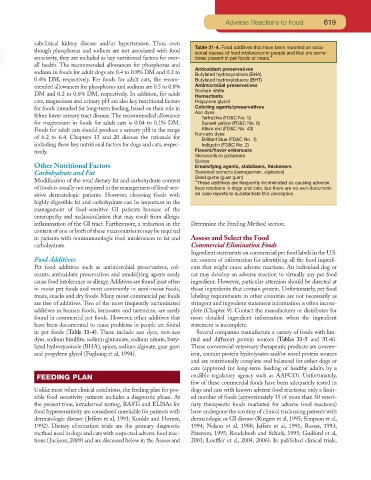Page 597 - Small Animal Clinical Nutrition 5th Edition
P. 597
Adverse Reactions to Food 619
subclinical kidney disease and/or hypertension. Thus, even Table 31-4. Food additives that have been reported as occa-
though phosphorus and sodium are not associated with food
VetBooks.ir sensitivity, they are included as key nutritional factors for over- sional causes of food intolerance in people and that are some-
times present in pet foods or treats.*
all health. The recommended allowances for phosphorus and
sodium in foods for adult dogs are 0.4 to 0.8% DM and 0.2 to Antioxidant preservatives
Butylated hydroxyanisole (BHA)
0.4% DM, respectively. For foods for adult cats, the recom- Butylated hydroxytoluene (BHT)
mended allowances for phosphorus and sodium are 0.5 to 0.8% Antimicrobial preservatives
DM and 0.2 to 0.6% DM, respectively. In addition, for adult Sodium nitrite
Humectants
cats, magnesium and urinary pH are also key nutritional factors Propylene glycol
for foods intended for long-term feeding, based on their role in Coloring agents/preservatives
feline lower urinary tract disease. The recommended allowance Azo dyes
Tartrazine (FD&C No. 5)
for magnesium in foods for adult cats is 0.04 to 0.1% DM. Sunset yellow (FD&C No. 6)
Foods for adult cats should produce a urinary pH in the range Allura red (FD&C No. 40)
of 6.2 to 6.4. Chapters 13 and 20 discuss the rationale for Non-azo dyes
Brilliant blue (FD&C No. 1)
including these key nutritional factors for dogs and cats, respec- Indigotin (FD&C No. 2)
tively. Flavors/flavor enhancers
Monosodium glutamate
Spices
Other Nutritional Factors Emulsifying agents, stabilizers, thickeners
Carbohydrate and Fat Seaweed extracts (carrageenan, alginates)
Modification of the total dietary fat and carbohydrate content Seed gums (guar gum)
*These additives are frequently incriminated as causing adverse
of foods is usually not required in the management of food-sen- food reactions in dogs and cats, but there are no well-document-
sitive dermatologic patients. However, choosing foods with ed case reports to substantiate this perception.
highly digestible fat and carbohydrate can be important in the
management of food-sensitive GI patients because of the
enteropathy and malassimilation that may result from allergic
inflammation of the GI tract. Furthermore, a reduction in the Determine the Feeding Method section.
content of one or both of these macronutrients may be required
in patients with nonimmunologic food intolerances to fat and Assess and Select the Food
carbohydrate. Commercial Elimination Foods
Ingredient statements on commercial pet food labels in the U.S.
Food Additives are sources of information for identifying all the food ingredi-
Pet food additives such as antimicrobial preservatives, col- ents that might cause adverse reactions. An individual dog or
orants, antioxidant preservatives and emulsifying agents rarely cat may develop an adverse reaction to virtually any pet food
cause food intolerance or allergy.Additives are found least often ingredient. However, particular attention should be directed at
in moist pet foods and most commonly in semi-moist foods, those ingredients that contain protein. Unfortunately, pet food
treats, snacks and dry foods. Many moist commercial pet foods labeling requirements in other countries are not necessarily as
are free of additives. Two of the most frequently incriminated stringent and ingredient statement information is often incom-
additives in human foods, benzoates and tartrazine, are rarely plete (Chapter 9). Contact the manufacturer or distributor for
found in commercial pet foods. However, other additives that more detailed ingredient information when the ingredient
have been documented to cause problems in people are found statement is incomplete.
in pet foods (Table 31-4). These include azo dyes, non-azo Several companies manufacture a variety of foods with lim-
dyes, sodium bisulfite, sodium glutamate, sodium nitrate, buty- ited and different protein sources (Tables 31-5 and 31-6).
lated hydroxyanisole (BHA), spices, sodium alginate, guar gum These commercial veterinary therapeutic products are conven-
and propylene glycol (Fuglsang et al, 1994). ient, contain protein hydrolysates and/or novel protein sources
and are nutritionally complete and balanced for either dogs or
cats (approved for long-term feeding of healthy adults by a
FEEDING PLAN credible regulatory agency such as AAFCO). Unfortunately,
few of these commercial foods have been adequately tested in
Unlike most other clinical conditions, the feeding plan for pos- dogs and cats with known adverse food reactions; only a limit-
sible food sensitivity patients includes a diagnostic phase. At ed number of foods (approximately 15 of more than 50 veteri-
the present time, intradermal testing, RASTs and ELISAs for nary therapeutic foods marketed for adverse food reactions)
food hypersensitivity are considered unreliable for patients with have undergone the scrutiny of clinical trials using patients with
dermatologic disease (Jeffers et al, 1991; Kunkle and Horner, dermatologic or GI disease (Rutgers et al, 1995; Simpson et al,
1992). Dietary elimination trials are the primary diagnostic 1994; Nelson et al, 1988; Jeffers et al, 1991; Rosser, 1993;
method used in dogs and cats with suspected adverse food reac- Paterson, 1995; Roudebush and Schick, 1995; Guilford et al,
tions (Jackson, 2009) and are discussed below in the Assess and 2001; Loeffler et al, 2004, 2006). In published clinical trials,

